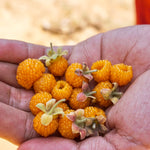Subscribe and save 10%!

Golden Himalayan Raspberry (Rubus ellipticus)
40 SEK
Unit price perExpected delivery date: 21 December to 28 December.
Applies to orders within Sweden. For other countries - see our delivery terms .
Out of stock
Meddela mig när produkten finns i lager:
Share
SEEDS (30pcs/bag)
Common names: Golden Himalayan Raspberry, Golden Evergreen Raspberry, Yellow Himalayan Raspberry, Ainselu
Scientific name: Rubus ellipticus
Family: Rosaceae
Plant history & use:
The Golden Himalayan Raspberry originates from the Himalayan mountain range in Tibet and Nepal, but also grows wild at high altitudes in more southern latitudes such as Sri Lanka and Southeast Asia.
The berries have a sweet flavor with a pleasant level of acidity.
Nepalese farmers grow and harvest Golden Himalayan Raspberries and then ferment the berries to produce a local fruit wine.
The berries have historically been used both as food and for medicinal purposes.
Scientific studies have revealed a wealth of macronutrients, micronutrients and various minerals in the berry ( Lamichhane A, Lamichhane G et al. ). Furthermore, the Golden Himalayan Raspberry has been shown to be rich in other beneficial substances, including polyphenols, flavonoids, anthocyanins, tannins and terpenoids.
In local communities where raspberries grow wild, consumption of the berries is still practiced as in the past. The berries are sold in local markets in the Himalayan region (Manandhar. NP).
The inner bark is valued as a medicinal herb in traditional Tibetan medicine.
In forest horticulture, the plant is traditionally grown in living fences in the northwestern Himalayas, where it helps to keep out livestock and other animals; mark land boundaries; while providing a range of medicinal and edible uses (Pankaj Sharma & Usha Devi). The plant is also useful in preventing soil erosion and for other soil conservation purposes (Manandhar. NP).
This species is also used in raspberry breeding programs, where it is crossed with certain varieties to impart its resistance to diseases and to improve its adaptability to warmer climates (Janick, J. & JN Moore).
From the berries, you can (surprisingly) extract a blue-purple dye that can be used in natural dyeing (Grae. I.).
Culture:
The Golden Himalayan Raspberry is said to be an evergreen shrub in its natural environment - possibly even in the mildest parts of our country. The shrub produces a cluster of stout, thorny, upright stems from a woody rootstock. The shrub usually grows 1-3 m tall, sometimes up to 4.5 m.
Easy to grow plant that thrives best in well-drained clay soil. Good hardiness to freezing temperatures, exact hardiness is difficult to find due to its rarity in commercial cultivation, but cases of hardiness down to -20ºC have been reported ( AK Trivedi )
More shade tolerant than many other species in the Raspberry genus (Rubus sp.). However, the best location for maximum fruit set is a sunny location.
Annual harvest from wild specimens in the Himalayas is about 750 g from a bush occupying an area of 2.5 m² (Parmar. C. and Kaushal. MK).
The shrub is self-fertile and pollinated by insects. New stems are produced each year from the perennial rootstock, these stems set fruit in their second year and then die off to be replaced by last year's fruit-bearing stems the following year.
Root tubers collected from plants in Java showed nitrogen-fixing activity and can be assumed to fix their own nitrogen like most plants in the Fabaceae family (MJ Van Steeniis-Kruseman).
Sowing:
NOTE: These seeds have been stratified (cold period) and can therefore be sown immediately after receipt.
Sow the seeds in moist soil. Cover with a thin layer (about 1 cm) of soil. Keep the seeds moist.
Features:
Year: Perennial
Growing position: sun
Height: 1-4 m
Germination time: 1-3 weeks
USDA zone : 7-10
Growing zone (rough translation): 1-3
- Choosing a selection results in a full page refresh.
- Opens in a new window.

















